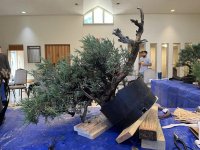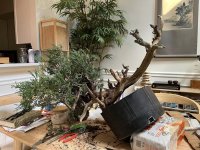WEI
Yamadori
This tree has become the favorite of my small collection. A few months ago, I procured a RMJ that was collected by Randy Knight about 2 years ago. The previous owner did a great job nurturing it post-collection, and I determined that given how healthy it seemed, it was ready for styling in the fall.
This is the tree right before it shipped out from Oregon.

In the meantime, I mocked up a bunch of renderings virtually and through drawings. Below are just a few, but I knew that this tree's deadwood would lend itself well to some sort of semi-cascade design.


When my local bonsai club gave notice that Sergio would be hosting a workshop, I signed up. He convinced me to go with a front similar to the first design above, with the caveat that the big hunk of the highest branch was too thick and straight to integrate. The first virtual rendering above was also too manicured. We agreed that leaning into the 'wild' nature of the tree would bring out its best.

Half the foliage disappeared with the creation of two jins. With this tree, the volume of the foliage I could work with (as seen above) was unfortunately a bit misleading. Almost all of the removed foliage was twiggy new growth sprouting in all directions from a few spots, creating inverse taper. Cleaning this tree was like raking dirt - a lot of fine decomposed bark and dead foliage accumulated in crevices.

I then started some structural wiring. Here's a shot on the work in progress.

Most structural wiring completed:

Closeups showcasing the lower apex and the deadwood, with the second apex still in need of more fine-tuning.



And here it is after more than a few hours of detail work.

The back arguably has the more interesting deadwood feature up top, but neglects everything below. It still needs a lot of wire.

I'll probably finish the remaining wiring job this or next weekend. Something about the left part of the tree still sits a little unwell with me. Maybe it's the fact that there's no main trunk in the lower dome, which is built out of multiple branches spread out like octopus tentacles. Or maybe there doesn't need to be a second dome, and I could break it into individual foliage pads.
That said, as I step back and look at this tree, the first thought that comes to mind is how untamed it still looks. I was initially drawn by the deadwood piercing through the canopy. Now the jin that claw forth and upward from the trunk call to me equally, if not more. I still have to tease out the live veins, clean the deadwood, and apply some lime sulfur/india ink.
Repotting will come in late spring 2025. On pot choice, I'm looking for something either rugged/naturalistic or unconventional, like the below. Appreciate any advice on potters who specialize in either!

Shoutout again to @MACH5 for the tremendously helpful pointers!
This is the tree right before it shipped out from Oregon.

In the meantime, I mocked up a bunch of renderings virtually and through drawings. Below are just a few, but I knew that this tree's deadwood would lend itself well to some sort of semi-cascade design.


When my local bonsai club gave notice that Sergio would be hosting a workshop, I signed up. He convinced me to go with a front similar to the first design above, with the caveat that the big hunk of the highest branch was too thick and straight to integrate. The first virtual rendering above was also too manicured. We agreed that leaning into the 'wild' nature of the tree would bring out its best.

Half the foliage disappeared with the creation of two jins. With this tree, the volume of the foliage I could work with (as seen above) was unfortunately a bit misleading. Almost all of the removed foliage was twiggy new growth sprouting in all directions from a few spots, creating inverse taper. Cleaning this tree was like raking dirt - a lot of fine decomposed bark and dead foliage accumulated in crevices.

I then started some structural wiring. Here's a shot on the work in progress.

Most structural wiring completed:

Closeups showcasing the lower apex and the deadwood, with the second apex still in need of more fine-tuning.



And here it is after more than a few hours of detail work.

The back arguably has the more interesting deadwood feature up top, but neglects everything below. It still needs a lot of wire.

I'll probably finish the remaining wiring job this or next weekend. Something about the left part of the tree still sits a little unwell with me. Maybe it's the fact that there's no main trunk in the lower dome, which is built out of multiple branches spread out like octopus tentacles. Or maybe there doesn't need to be a second dome, and I could break it into individual foliage pads.
That said, as I step back and look at this tree, the first thought that comes to mind is how untamed it still looks. I was initially drawn by the deadwood piercing through the canopy. Now the jin that claw forth and upward from the trunk call to me equally, if not more. I still have to tease out the live veins, clean the deadwood, and apply some lime sulfur/india ink.
Repotting will come in late spring 2025. On pot choice, I'm looking for something either rugged/naturalistic or unconventional, like the below. Appreciate any advice on potters who specialize in either!

Shoutout again to @MACH5 for the tremendously helpful pointers!
Last edited:




